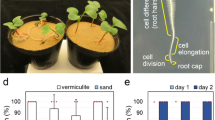Summary
A portion of a single plant root is treated as an absorbing cylindrical sink to which nutrients move by diffusion. Assuming that the rate of uptake of nutrient is proportional to its concentration at the root surface, and that the nutrient, though reacting with the solid, moves only through the soil solution, standard diffusion equations are used to calculate the effect of soil and plant characteristics on the rate of uptake. The treatment is applicable to phosphorus and potassium. Among soil properties uptake should increase directly with the soil solution concentration. It should also increase, but only slowly, with increasing buffering power. It increases with increasing soil moisture. Among plant characteristics, uptake should increase with the root absorbing power until diffusion through the soil becomes limiting. Absorption by unit surface area of root increases as the root radius decreases. A root hair is shown to interfere quickly with the uptake of adjacent hairs. The hairs increase absorption by the root because they can exploit rapidly the soil between the hairs, and they have the effect of extending the effective root surface to their tips.
Similar content being viewed by others
References
Barber, S. A., Walker, J. M. and Vasey, E. H., Principles of ion movement through the soil to the plant root. Intern. Soil. Conf. New Zealand, 121–124 (1962).
Beckett, P. H. T., Studies on soil potassium II. The ‘immediate’ Q/I relations of labile potassium in the soil. J. Soil Sci.15 9–23 (1964).
Blanchet, R., Relations entre la vitesse de dilution isotopique du phosphore du sol et l'alimentation phosphatée des plantes. Compt. Rend.244 2739–2741 (1957).
Bouldin, D. R., Mathematical description of diffusion processes in the soil-plant system. Soil Sci. Soc. Am. Proc.25 476–480 (1961).
Carslaw, M. S. and Jaeger, J. C., Conduction of Heat in Solids-(2nd Edition) Oxford (1959).
Crank, J., The Mathematics of Diffusion, Oxford (1956).
Dittmer, H. J., A quantitative study of the subterranean members of soyabean. Soil Cons.6 33–34 (1940).
Gardner, W. R., Dynamic aspects of water availability to plants. Soil Science89 63–73 (1960).
Kramer, P. J. and Coile, T. S., An estimation of the volume of water made available by root extension. Plant Physiol.15 743–747 (1940).
Lewis, D. G. and Quirk, J. P., Diffusion of phosphate in soil. Intern. Soil Conf. New Zealand 132–138 (1962).
Mattingly, G. E. G., Russell, R. D. and Jephcott, B. M., Experiments on cumulative dressings of fertilizers on calcareous soils in South-West England. II — Phosphorus uptake by Ryegrass in the greenhouse. J. Sci. Food and Agr.9 629–637 (1963).
Moss, P., Some aspects of the cation status of soil moisture. Pt. I. The ratio law and moisture content. Plant and Soil18 99–113 (1963).
Nye, P. H., Soil analysis and the assessment of fertility in tropical soils. J. Sci. Food and Agr.14 277–280 (1963).
Nye, P. H., The measurement and mechanism of ion diffusion in soils. I. The relation between self-diffusion and bulk diffusion. J. Soil Sci.17 16–23 (1966).
Nye, P. H. and Spiers, J. A., Simultaneous diffusion and mass flow to plant roots. Trans. 8th Intern Congr. Soil Sci. Bucharest (1964) (in press).
Olsen, S. R., Kemper, W. D. and Jackson, R. D., Phosphate diffusion to plant roots. Soil Sci. Soc. Am. Proc.26 222–227 (1962).
Passioura, J. B., A mathematical model for the uptake of ions from the soil solution. Plant and Soil18 225–238 (1963).
Porter, L. K., Kemper, W. D., Jackson, R. D. and Stewart, B. A., Chloride diffusion in soils as influenced by moisture content. Soil Sci. Soc. Am. Proc.24 460–463 (1960).
Russell, R. S., Martin, R. P. and Bishop, O. N., A study of the absorbtion and utilization of phosphate by young barley plants. III — The relationship between external concentration and the absorbtion of phosphate. J. of Exptl. Botany5 327–342 (1954).
Scott, F. M., Root hair zone of soil grown roots. Nature199 1009–1010 (1963).
Wiersum, L. K., Utilization of soil by the plant root system. Plant and Soil15 189–191 (1961).
Williams, E. G., Chemical soil tests as an aid to increased productivity. Intern. Soil Conf. New Zealand, 820–834 (1962).
Author information
Authors and Affiliations
Rights and permissions
About this article
Cite this article
Nye, P.H. The effect of the nutrient intensity and buffering power of a soil, and the absorbing power, size and root hairs of a root, on nutrient absorption by diffusion. Plant Soil 25, 81–105 (1966). https://doi.org/10.1007/BF01347964
Received:
Issue Date:
DOI: https://doi.org/10.1007/BF01347964




